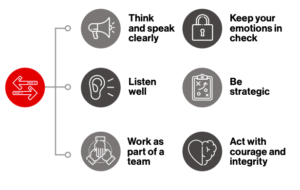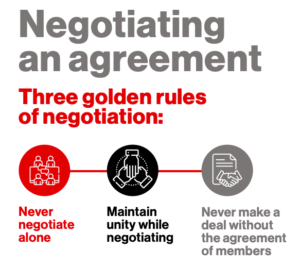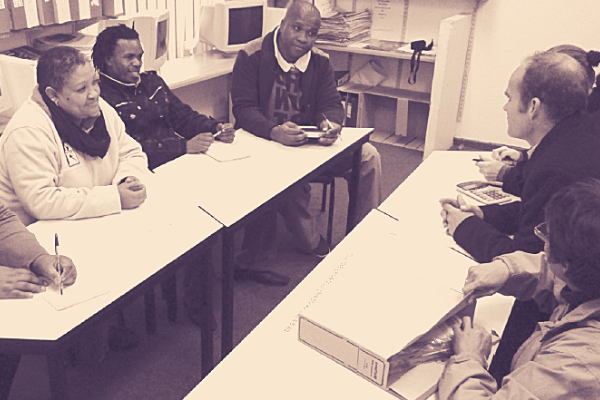
The process of negotiations
Each side will be given an opportunity to state and make arguments for their proposal (demands and offers). You need to state your case simply and clearly. Show the other party that you know what you are talking about and have confidence while stating your case. Your team members will motivate demands allocated to them to strengthen your case.
There will be agreements and disagreements.
Negotiators’ emotions will be tested which can lead to anger, frustration and personal attacks. Stay calm and focus on the issues or offers put forward by management. Do not shy away from asking the opposite negotiating team for clarity or an explanation regarding their position, offer or response.
If you agree with some of the demands from the other party, get agreement ‘in principle’ to avoid confusion when there’s a dispute.
Listen actively to the opposition’s comments or responses and watch their body language while you are stating your case. This will assist in predicting whether an agreement can be reached without hiccups.
It is very important to keep an open mind when it comes to the kind of agreement you would like to reach. For example, the agreement must offer an acceptable solution to both parties (workers and management). The agreement must be inclusive (cover all workers in the workplace/sector, including workers in vulnerable sectors). It is worth giving some thought to how you might get movement and agreement.
Caucus
What happens if you feel that you are losing the arguments, or there’s disagreement in your team regarding some issues? Shop stewards should never disagree with one another in front of management. Stop the negotiations and request a caucus to think, get more information or manage your emotions. This means that you take a break away from the main group to speak among your negotiating team. This mechanism (caucus) will also allow you to touch base with your constituency regarding the progress of the negotiations. Before you take the caucus, summarise what you have discussed so far and where in the process you find yourselves. This will help both parties to resume without holdups after the interval.
During negotiations, negotiators may feel the need to alter their position, changing what the workers have mandated. They need to discuss this in a caucus. Even if the negotiator agrees to a new position, they can only take this as a recommendation to workers. The negotiator is not at liberty to make an agreement that has not been approved by the people they represent.
Trust and good faith
Bargaining in good faith means that ‘once a negotiator makes an offer it cannot be retracted, and an agreement, once reached, is enforceable’. In simpler terms, this means that when bargaining in good faith, neither party can withdraw an offer, and once an agreement is made, it has to be put into effect.
Successful processes focus not only on the issues at hand but also on creating an effective working relationship between parties in order for them to negotiate in good faith. 15 When negotiators trust each other, there is more cooperation.
This is sometimes called the ‘dilemma of trust’. While the parties involved should show their integrity, they should not appear weak or give too much information. Do not make a promise you do not intend to keep, as this shows ‘bad faith’.
Feedback to members
Always keep in mind that you represent workers and therefore keep them informed about progress in the bargaining table. Identify issues where there’s no agreement and request a fresh mandate from members. Make sure that members understand all the processes leading to the dispute mechanism if there’s no agreement reached.
After every round of negotiation, the negotiating team must report back to the workers who will be affected by the outcome of the negotiations. In giving a report back it is important to present accurately how management has responded to workers’ demands and what offers it is making. The negotiators should also give workers their assessment of how things are going and they should give recommendations about how to move forward. After a full discussion, the negotiators should get a new mandate. Sometimes workers will give negotiators a fall-back position that they will accept if they cannot win their first demand.
Reaching agreement with members can be a difficult step, especially if you have not won everything they demanded:
- Plan carefully how you will report back to workers.
- Plan collectively. Make sure every member of the negotiating team has the same understanding and agrees to the chosen report-back approach.
- Prepare support materials such as pamphlets and charts to help you explain what has been agreed or recommended. This is especially important if you are unable to convene all workers at one meeting.
- Explain to workers what happened and why. Give some life and colour to the explanation.
- Be honest in your explanation.
- Be calm. Use emotion and anger in a controlled way.
- Put forward options for workers to consider.
- Listen to all viewpoints, including those of women, and try not to allow one person or position to dominate.
- If workers are divided, take time to work through the issues and options. Be positive about the progress made.
- Try to reach consensus amongst workers – or at least consensus amongst the majority. If not, you may have to use a voting process.
Agreement

Reaching agreement checklist
- The agreement is in writing
- The agreement gives clear guidance on what is to be implemented and how it is to be implemented
- The clauses of the agreement worded in a way that lends itself to a single interpretation of what is to be implemented and how it is to be implemented
- The clauses of the agreement are not too vague and open to different interpretations of how they should be implemented.
- The start and end date of the agreement are clearly stated
- It is clear who is covered by the agreement
- The agreement is worded in a way that can be understood easily by member
Reaching deadlock
If no agreement is reached, then negotiators must go back to the workers and discuss what to do. If there is no acceptable compromise that can be seen then the workers need to look at the possibility of declaring a dispute.
If there is a decision to declare a dispute, then it is important to be clear about the courses of action that can be taken legally and which choices there are outside of the law. For this, it is important to know what has already been agreed to in any collective agreement, and to know what the Labour Relations Act says about dispute procedures and industrial action.
It is also important not to delay taking a course of action. Although there are no longer time limits on cases going to the Commission for Conciliation, Mediation and Arbitration (CCMA) [except for unfair dismissals] workers will lose interest and confidence if a dispute is neglected.
Implementation
This is a crucial phase in the collective bargaining process.
Before the agreement is signed, make sure to read and understand every clause. Share the agreement with your constituency, leadership and/or legal department to check, amend or give input. File the agreement safely for future referencing. Review the negotiations with your team and address any challenges encountered at the bargaining table.
Once agreement has been reached, what happens? It’s not only the process of negotiation that is important, but also what happens after an agreement has been reached. For an agreement to be considered legitimate, it should be successfully implemented. In this sense, the agreement itself is only the beginning of the process.
Do follow up and make sure that what was agreed in the bargaining table is being implemented as per the collective agreement. Share the final agreement(s) with your members or constituency. Review the negotiations with your team and address any challenges encountered at the bargaining table.
Use the agreement as a catalyst
You have gained a victory for workers. Their spirits are high and they are positive about what the organisation can do. Build on this!
- Use it as an educational tool. What lessons have we learned? Give yourself time to reflect on the experience of negotiating.
- Use it to raise awareness of issues, about negotiations and about the organisation.
- Get workers to go out, spread the word and bring in new members.
- Provide publicity on the agreement.
- Celebrate the victory!
The structure and process of collective bargaining vary considerably across bargaining levels and sectors in the formal and informal economy. Negotiators need to keep enhancing their skills and abilities to adapt to the collective bargaining environment as the world of work is changing.
You might also like:11 steps you should take to prepare for wage bargaining







